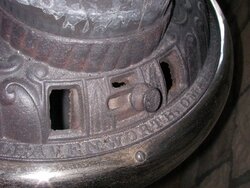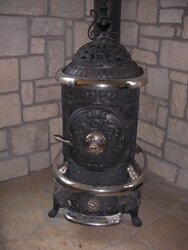I've spent the afternoon researching fires. For one thing, I know now that I open the door WAY too much. I just need to let the fire do its thing.
Getting a good overnight fire is a little beyond me. If someone could explain the process, that would be fantastic!
I have a Great Western 1521. It has the ash door in the bottom which I usually crack a wee bit to cause a draft, and then close up after the fire is roaring. The middle handle on the main door (see picture) does unscrew, so that is the real draft as there is a metal pocket behind it, but I never use because it seems a hassle to screw and unscrew.
Also, on the top behind the pipe is a sliding draft or damper (I think?) I included a picture of that as well. I've never used it because I actually don't know what it is for. How do I work all these openings to get my fire going well, and keep going through most of the night? We also have a damper on the pipe, which I am pretty good at using. I close up all the dampers before bed, so I get a nice slow fire. I'm just concerned about the amount of ASH that I get.
Here's a couple more questions. I can easily stand the wood up and pack it in but would it burn faster than laying down? Also, I read where it said to keep the wood within 4-6" but some of our pieces are HUGE. Does it really matter once you've got the fire going to use the large ones?
Getting a good overnight fire is a little beyond me. If someone could explain the process, that would be fantastic!
I have a Great Western 1521. It has the ash door in the bottom which I usually crack a wee bit to cause a draft, and then close up after the fire is roaring. The middle handle on the main door (see picture) does unscrew, so that is the real draft as there is a metal pocket behind it, but I never use because it seems a hassle to screw and unscrew.
Also, on the top behind the pipe is a sliding draft or damper (I think?) I included a picture of that as well. I've never used it because I actually don't know what it is for. How do I work all these openings to get my fire going well, and keep going through most of the night? We also have a damper on the pipe, which I am pretty good at using. I close up all the dampers before bed, so I get a nice slow fire. I'm just concerned about the amount of ASH that I get.
Here's a couple more questions. I can easily stand the wood up and pack it in but would it burn faster than laying down? Also, I read where it said to keep the wood within 4-6" but some of our pieces are HUGE. Does it really matter once you've got the fire going to use the large ones?
Attachments
Last edited:




